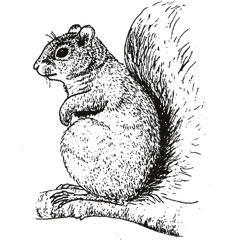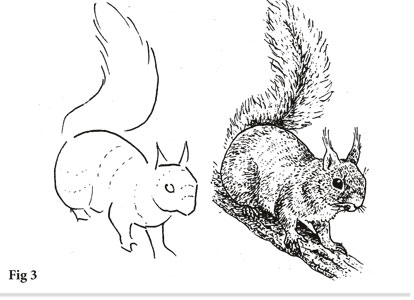 
Bushy-tailed squirrel
 The
bushy tailed squirrel is a wild animal which is the bigger cousin of the
little squirrel we are so familiar within our country. It is very
similar in appearance except for the size and colour of fur. The common
local squirrel is small and has stripes on its back. Today we'll learn
to draw the larger bushy-tailed squirrel. The
bushy tailed squirrel is a wild animal which is the bigger cousin of the
little squirrel we are so familiar within our country. It is very
similar in appearance except for the size and colour of fur. The common
local squirrel is small and has stripes on its back. Today we'll learn
to draw the larger bushy-tailed squirrel.
Always bear in mind when drawing any animal that if you draw the main
shape accurately, the rest is relatively easy. You will find that the
shape of a squirrel's head is very similar to that of a mouse or a
rabbit. You will observe this by studying Figure 1. See also the way I
have suggested the tail by drawing long pen strokes which generally
radiate around the tail itself.
The fur nearest the tail bone is dark grey but this turns to white at
the outside. To get this impression I have left white space in abundance
at the back of the tail. I have used short lines which look the same way
as it grows on the animal to suggest body fur texture.
You will notice that the squirrel has small rounded ears, short
whiskers, dark eyes, long hind legs and toes and human like hands. Study
these carefully and copy the basic outline first and then draw neatly in
pencil at the start. Ink them after drawing the full figure of the
squirrel. Observe how the curves and roundness have been drawn by short
pen strokes.
Practise until you are able to draw from memory.
Another view
Figure 3 shows on the left, the outline sketch of a squirrel in a
pose commonly seen. The oval shaped body is clearly outlined.
Notice how the hair radiates from the central bone on the squirrel on
the right. There are long tufts of hair on its ears. The nose is small
with a gently covered mouth with a few whiskers on either side.
The sketch shows the animal with a watchful eye sitting upon a
branch. Always bear in mind when drawing any animal that if you draw the
main shape accurately, the rest is relatively easy. With a little
practice you will soon get these proportions right.

Changing shapes
The grey squirrel like so many animals can suddenly change shape. It
is a very fast moving creature which can climb and bound across open
ground at great speed.
Figure 2 shows the squirrel sliding down a wire supported on top of a
small cage. The left illustration shows the basic outline and the right,
the completed drawing.
Notice the flowing lines made by tail and body and how the head is
angled out. The fur on the tail is drawn in pen and ink with a thin nib.
Well placed long lines suggest the fine hair on the tail, while short
lines are used for the softer texture on the rest of the body.
The soft pencil is much more suited to begin with. Study the drawings
and pay attention to body shapes, eyes, ears, mouth, head and long tail.
Then copy each drawing in pencil HB2 before completing the figure in pen
and ink. |


